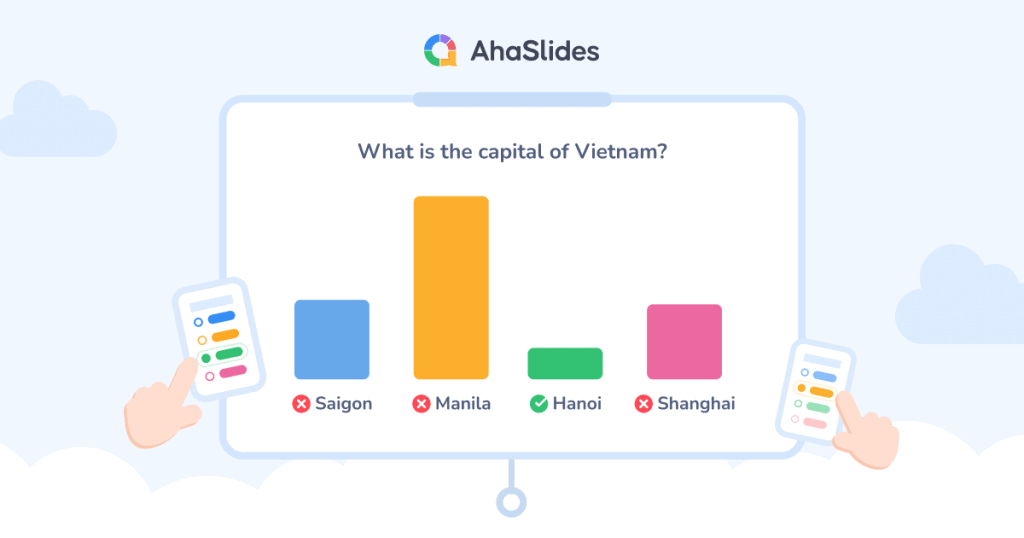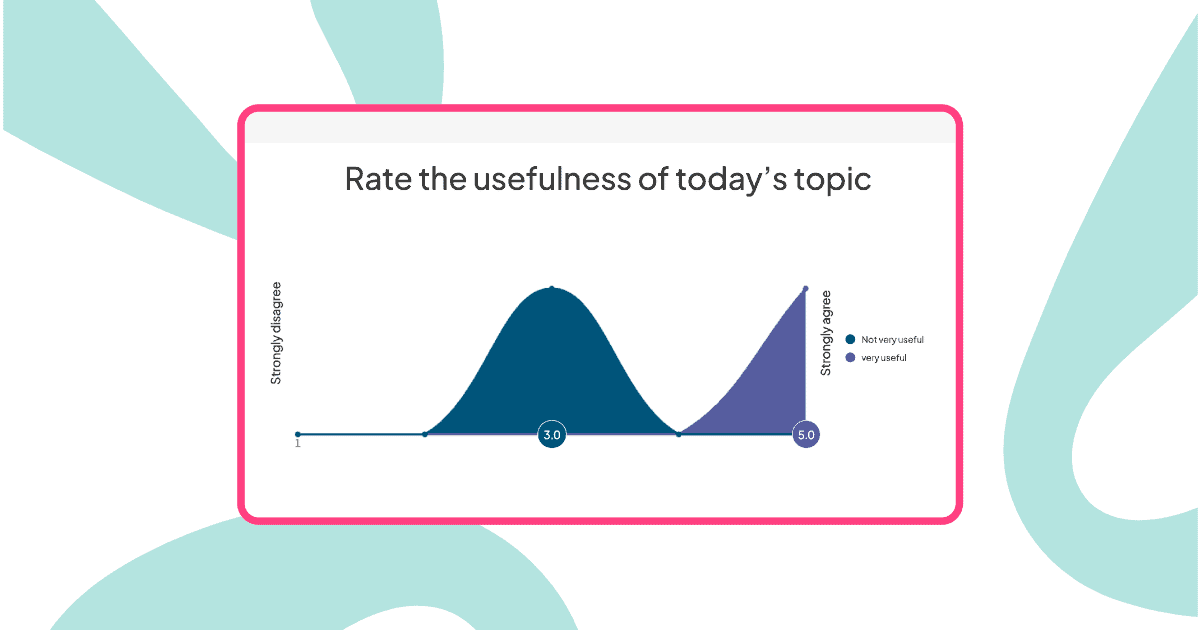Questionnaires are clutch for rounding up details from people all over the place.
Even though questionnaires are everywhere, people still aren't sure which kinds of queries to add down.
We'll show you the common types of questionnaires in research, plus how and where to use one.
Let's jump right in👇
More Tips with AhaSlides
Types of Questionnaires in Research
When making your questionnaire, you have to think about what type of information you trying to get from people.
If you want rich, exploratory details to help prove or debunk a theory, go with a qualitative survey with open-ended questions. This lets people freely explain their thoughts.
But if you already have a hypothesis and just need numbers to test it, a quantitative questionnaire is the jam. Use closed questions where folks pick answers to get measurable, quantifiable stats.
Once you've got it, now it's time to choose what type of questionnaire in research you'd like to include.

#1. Open-ended questionnaires
Open-ended questions are a valuable tool in research as they allow subjects to fully express their perspectives without limitations.
The unstructured format of open-ended questions, which do not provide predefined answer choices, makes them well-suited for exploratory research early on.
This allows investigators to uncover nuanced insights and potentially identify new avenues for investigation that had not been conceived previously.
While open-ended questions generate qualitative rather than quantitative data, requiring more in-depth coding methods for analysis across large samples, their strength lies in revealing a wide range of thoughtful responses.
Commonly used as introductory questions in interviews or pilot studies to explore explanatory factors, open-ended queries are most useful when a topic needs to be understood from all angles before designing more direct closed-question surveys.
Example:
Opinion questions:
- What are your thoughts on [topic]?
- How would you describe your experience with [topic]?
Experience questions:
- Tell me about a time when [event] occurred.
- Walk me through the process of [activity].
Feeling questions:
- How did you feel about [event/situation]?
- What emotions are evoked when [stimulus] is present?
Recommendation questions:
- How could [issue] be improved?
- What suggestions do you have for [proposed solution/idea]?
Impact questions:
- In what ways has [event] affected you?
- How have your views on [topic] changed over time?
Hypothetical questions:
- How do you think you would react if [scenario]?
- What factors do you think would influence [outcome]?
Interpretation questions:
- What does [term] mean to you?
- How would you interpret the finding that [result]?
#2. Rating scale questionnaires

Rating scale questions are a valuable tool in research for measuring attitudes, opinions, and perceptions that exist on a continuum rather than as absolute states.
By presenting a question followed by a numbered scale for respondents to indicate their level of agreement, importance, satisfaction, or other ratings, these questions capture the intensity or direction of feelings in a structured yet nuanced way.
Common types include Likert scales involving labels like strongly disagree to strongly agree as well as visual analogue scales.
The quantitative metric data they provide can then be easily aggregated and statistically analysed to compare mean ratings, correlations, and relationships.
Rating scales are well suited for applications like market segmentation analysis, pre-testing, and post-implementation program evaluation through techniques such as A/B testing.
While their reductive nature may lack the context of open responses, rating scales still efficiently gauge sentiment dimensions for examination of predictive links between attitude facets when appropriately placed after initial descriptive inquiry.
#3. Closed-ended questionnaires

Closed-ended questions are commonly used in research to collect structured, quantitative data through standardised answer choices.
By providing a restricted set of response options for subjects to select from, such as true/false, yes/no, rating scales or predefined multiple choice answers, closed-ended questions yield responses that can be more easily coded, aggregated, and statistically analysed across large samples compared to open-ended questions.
This makes them suitable during later validation phases after factors have already been identified, such as hypothesis testing, measuring attitudes or perceptions, subject ratings, and descriptive inquiries relying on fact-based data.
While limiting responses simplifies surveying and allows for direct comparison, it risks omitting unanticipated issues or losing context beyond the given alternatives.
#4. Multiple choice questionnaires
Multiple choice questions are a useful tool in research when administered properly through closed questionnaires.
They present respondents with a question along with four to five pre-defined answer options from which to select.
This format allows for easy quantification of responses that can be statistically analysed across large sample groups.
While quick for participants to complete and straightforward to code and interpret, multiple-choice questions also carry some limitations.
Most notably, they risk overlooking important nuances or missing relevant options if not carefully pilot-tested beforehand.
To minimise the risk of bias, answer choices must be mutually exclusive and collectively exhaustive.
With considerations for wording and options, multiple choice questions can efficiently yield measurable descriptive data when the key possibilities are pre-identified, such as for classifying behaviours, and demographic profiles or assessing knowledge on topics where variations are known.
#5. Likert scale questionnaires
The Likert scale is a commonly used type of Rating scale in research to quantitatively measure attitudes, opinions, and perceptions on various topics of interest.
Utilising a symmetrical agree-disagree response format where participants indicate their level of agreement with a statement, Likert scales typically feature a 5-point design although more or fewer options are possible depending on the needed sensitivity of measurement.
By assigning numeric values to each level of the response scale, Likert data allows for statistical analysis of patterns and relationships between variables.
This yields more consistent results than simple yes/no or open-ended questions for certain types of questions aimed at gauging the intensity of sentiments on a continuum.
While Likert scales provide easily collectable metric data and are straightforward for respondents, their limitation is oversimplifying complex viewpoints, though they still offer valuable insight when properly applied in research.
Example
A researcher wants to understand the relationship between job satisfaction (dependent variable) and factors like pay, work-life balance, and supervision quality (independent variables).
A 5-point Likert scale is used for questions like:
- I am satisfied with my pay (Strongly disagree to Strongly agree)
- My job allows for a good work-life balance (Strongly disagree to Strongly agree)
- My supervisor is supportive and a good manager (Strongly disagree to Strongly agree)
We cover all types of questionnaires in research. Get started right away with AhaSlides' free survey templates!
Key Takeaways
These types of questionnaires in research are typically common and easy for people to fill out.
When your queries are straightforward to grasp and your options are uniform, everyone's on the same page. Answers then compile nicely whether you got one response or a million.
The key is making sure respondents always know exactly what you're asking, and then their replies will slide right into place for the smooth assembly of sweet survey scoops.
Frequently Asked Questions
What are the 4 types of questionnaires in research?
The four main types of questionnaires used in research are structured questionnaires, unstructured questionnaires, surveys and interviews. The appropriate type depends on the research objectives, budget, timeline and whether qualitative, quantitative or mixed methods are most suitable.
What are the 6 main types of survey questions?
The six main types of survey questions are closed-ended questions, open-ended questions, rating scale questions, ranking scale questions, demographic questions and behavioural questions.
What are the three types of questionnaires?
The three main types of questionnaires are structured questionnaires, semi-structured questionnaires and unstructured questionnaires.











